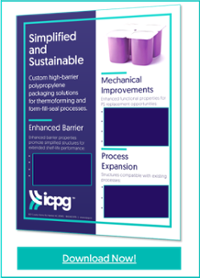 Form fill seal (FFS) is a type of high-efficiency automated assembly-line food packaging conversion process crucial in the food packaging industry. This method expands the traditional deposit-fill-seal or fill-seal food process by thermoforming the cups or containers in-line, then trimming the cups out of the plastic web into individual or multi-pack configurations.
Form fill seal (FFS) is a type of high-efficiency automated assembly-line food packaging conversion process crucial in the food packaging industry. This method expands the traditional deposit-fill-seal or fill-seal food process by thermoforming the cups or containers in-line, then trimming the cups out of the plastic web into individual or multi-pack configurations.
FFS is particularly well-suited for high volume production where there are limited sizes and change overs due to the highly complex nature of these machines and the functioning process.
Processing dairy products and other shelf-stable foods through form fill and seal systems enables high volume production of single size containers. This process utilizes unique barrier material structures that maintain the integrity of the food product, while providing unique packaging to support package performance and brand differentiation.
How does the Form Fill Seal (FFS) Process Work?
The form fill seal packaging process is a type of automated process designed to form rollstock from rigid flat sheet into thermoformed containers which are subsequently filled and sealed all in one operation.
For barrier food applications that are processed on aseptic processing FFS lines, the sheet or rollstock are fed from an unwind station through a steam tunnel or hydrogen peroxide bath for sterilization before entering the sealed aseptic chamber. In this instance and with non-aseptic FFS lines, the rollstock is then fed through a set of heating stations where the plastic sheet is heated to the required forming temperature. Following the heat stations, the rollstock is then thermoformed into cups which remain in the rollstock web and then travel into the filling stations.
Today's sophisticated FFS machines have the capability to deposit a single food component or multiple components, such as fruit on the bottom with yogurt on top or as a tri-layer of chocolate/vanilla/chocolate pudding. Once filled, the web enters the lidding station where a lidstock is sealed to the containers and a die-cut operation then cuts the finished cups, 4 packs or 6 packs from the web change to single or array packs. The finished cup packs then proceed into casing or cartooning stations where the filled FFS cups are ready for shipping. Depending on the sterilization method and materials used, FFS packaged foods can have a shelf life ranging from 6-24 months depending on storage and supply chain conditions.
Examples of market applications that use the form fill seal process include:
Compatible Materials for Form Fill Seal Processes
 In addition to the form fill seal process and chosen sterilization method, choosing a material structure that provides a combination of oxygen and moisture barrier properties also helps to extend the shelf life and reduce food spoilage and waste. ICPG produces custom barrier rollstock solutions using polystyrene and polypropylene for rigid thermoformed containers designed for automatic filling systems like form fill and seal processes.
In addition to the form fill seal process and chosen sterilization method, choosing a material structure that provides a combination of oxygen and moisture barrier properties also helps to extend the shelf life and reduce food spoilage and waste. ICPG produces custom barrier rollstock solutions using polystyrene and polypropylene for rigid thermoformed containers designed for automatic filling systems like form fill and seal processes.
When developing the rollstock structure for barrier packaging applications, factors including food product, part design, processing conditions, distribution environment and retail conditions must all be considered as each variable ultimately affects shelf-life performance.
Once these variables have been defined, further details such as barrier specifications, shelf-life expectations, part geometry, material attributes and part handling must all be considered to refine the design of the thermoformed part and develop a rollstock structure that will deliver optimal barrier performance.
Equally important is identifying the right lidding film, considering sealing integrity and barrier characteristics necessary to protect the products’ integrity for the targeted shelf life. Some options include both easy peel and weld seal (or, lock tight) peeling characteristics. Barrier properties of a lidding film must be matched to the barrier demands of the overall package. Because the rollstock for form fill seal applications is produced off-line on ICPG’s multilayer coextrusion line, this presents an excellent opportunity to customize the aesthetics of packaging containers to further enhance brand differentiation with enhancements such as custom colors, clear and clear tint materials and custom decorative laminations.
ICPG material solutions compatible with form fill and seal packaging can be customized to meet target extended shelf-life requirements with a custom multi-layer coextruded barrier rollstock structure. Depending on the end-use application and barrier requirements, ICPG can formulate customized coextruded barrier rollstock structures spanning using substrates such as Polystyrene, Polypropylene, and Polyethylene to meet the application requirements.
ICPG material solutions for FFS processes include:
-
- Mono-layer HIPS
- Custom color & bi-color HIPS
- Multi-layer coextruded HIPS/PE
- Multi-layer coextruded HIPS/EVOH/PE rollstock
- XPP Polypropylene Solutions
- Multi-layer coextruded PP/EVOH/PP rollstock
PS has long been the material of choice for FFS processes due to the materials' ease of processing. However, with Proposition 65 guidelines calling for material replacement in food packaging applications, the industry is looking for an alternative material to replace PS that will meet processing and application functional and barrier requirements.
Use of innovative new materials, such as ICPG's XPP Enhanced Barrier Polypropylene, can offer both enhancements to barrier performance, as well as improved mechanical properties to offer a polypropylene structure compatible with form fill and seal processes.
Download the XPP Polypropylene Solutions product sheet for more information on PS replacement solutions for FFS applications:




